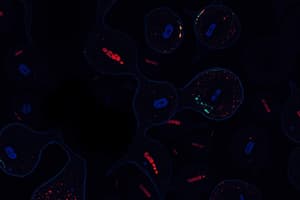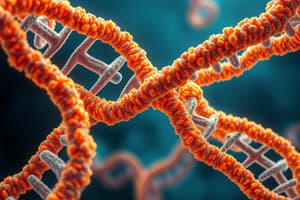Podcast
Questions and Answers
What role does the H1 histone play in the structure of the nucleosome?
What role does the H1 histone play in the structure of the nucleosome?
- It forms the core particle of the nucleosome.
- It participates in DNA replication directly.
- It enhances the flexibility of the nucleosome.
- It locks the DNA into place around the nucleosome. (correct)
What is a chromatosome composed of?
What is a chromatosome composed of?
- Two nucleosomes bound together.
- A nucleosome and associated H1 histone. (correct)
- Eight histone proteins and nonhistone proteins.
- A nucleosome and 30 bp of linker DNA.
What is the diameter of the fiber formed by tightly packed nucleosomes?
What is the diameter of the fiber formed by tightly packed nucleosomes?
- 250 nm
- 700 nm
- 30 nm (correct)
- 167 nm
What is the function of the centromere in a chromosome?
What is the function of the centromere in a chromosome?
How much DNA does each chromatosome encompass?
How much DNA does each chromatosome encompass?
What constitutes the chromosomal material in eukaryotic cells?
What constitutes the chromosomal material in eukaryotic cells?
Which histone proteins are included in the octamer core of a nucleosome?
Which histone proteins are included in the octamer core of a nucleosome?
What charge do histone proteins carry that facilitates their interaction with DNA?
What charge do histone proteins carry that facilitates their interaction with DNA?
Which of the following statements about heterochromatin is true?
Which of the following statements about heterochromatin is true?
What length of DNA is typically found in direct contact with the histone octamer in a nucleosome?
What length of DNA is typically found in direct contact with the histone octamer in a nucleosome?
Eukaryotic chromosomes consist of multiple separate DNA molecules.
Eukaryotic chromosomes consist of multiple separate DNA molecules.
Histones are negatively charged proteins that bind to the phosphates of DNA.
Histones are negatively charged proteins that bind to the phosphates of DNA.
Euchromatin consists of tightly packed DNA that is generally inaccessible for transcription.
Euchromatin consists of tightly packed DNA that is generally inaccessible for transcription.
The nucleosome is the simplest level of chromatin structure, consisting of DNA wrapped around an octamer of histone proteins.
The nucleosome is the simplest level of chromatin structure, consisting of DNA wrapped around an octamer of histone proteins.
The length of DNA that is in contact with the histone octamer in a nucleosome is typically between 150 and 155 base pairs.
The length of DNA that is in contact with the histone octamer in a nucleosome is typically between 150 and 155 base pairs.
The H1 histone is part of the core particle of the nucleosome.
The H1 histone is part of the core particle of the nucleosome.
A chromatosome encompasses approximately 167 bp of DNA.
A chromatosome encompasses approximately 167 bp of DNA.
The diameter of the tightly packed chromatin fiber is approximately 300 nm.
The diameter of the tightly packed chromatin fiber is approximately 300 nm.
Nonhistone chromosomal proteins can be associated with linker DNA.
Nonhistone chromosomal proteins can be associated with linker DNA.
Centromeric sequences serve as binding sites for histone proteins.
Centromeric sequences serve as binding sites for histone proteins.
Flashcards are hidden until you start studying
Study Notes
Eukaryotic Chromosome Structure
- Eukaryotic chromosomes consist of a single, extremely long molecule of DNA
- Eukaryotic DNA is closely associated with proteins, creating chromatin.
- Two basic types of chromatin: euchromatin, found in regions of chromosomes where genes are active and heterochromatin, found at the centromeres and telomeres.
Chromatin Structure
- The most abundant proteins in chromatin are the histones.
- There are five major types of histones: H1, H2A, H2B, H3, and H4.
- All histones are small, positively charged proteins that contain a high percentage of arginine and lysine.
- The positive charges on the histones attract the negative charges on the phosphates of DNA, holding the DNA in contact with the histones.
- Nonhistone chromosomal proteins, such as chromosomal scaffold proteins, may help in folding and packing the chromosome.
Nucleosome Structure
- The simplest level of chromatin structure is the nucleosome.
- The nucleosome is a core particle consisting of DNA wrapped twice around an octamer of eight histone proteins (two copies each of H2A, H2B, H3, and H4).
- The DNA in direct contact with the histone octamer is between 145 and 147 bp in length.
- The histone proteins have a flexible "tail," containing from 11 to 37 amino acids, that extends out from the nucleosome.
- The fifth type of histone (H1) is not part of the core particle but plays an important role in the nucleosome structure.
- H1 binds to 20 to 22 bp of DNA where the DNA joins and leaves the octamer histone.
- H1 helps to lock the DNA into place, acting as a clamp around the nucleosome octamer.
Chromatosome Structure
- The nucleosome octamer and its associated H1 histone are called the chromatosome.
- Each chromatosome encompasses about 167 bp of DNA.
- Chromatosomes are located at regular intervals along the DNA molecule and are separated from one another by linker DNA.
- Linker DNA comprises from about 30 to 40 bp.
High Order of Chromatin Structure
- Nucleosomes fold on themselves to form a dense, tightly packed structure that makes up a fiber with a diameter of about 30 nm.
- The next-higher level of chromatin structure is a series of loops of 30-nm fibers.
- Each loop encompasses 20,000 to 100,000 bp of DNA and is about 300 nm in length.
- The 300-nm loops are compressed and folded to produce a 250-nm-wide fiber.
- Tight helical coiling of the 250-nm fiber produces the chromatid of a chromosome, approximately 700 nm in width.
Centromere Structure
- The centromere is a constricted region of the chromosome to which spindle fibers attach.
- Centromeres display considerable variation in structure.
- The centromere is essential for proper chromosome movement in mitosis and meiosis.
- Centromeric sequences are the binding sites for the kinetochore, to which spindle fibers attach.
Telomere Structure
- Telomeres are the natural ends of a chromosome.
- Telomeres are regions of repetitive nucleotide sequences that stabilize the ends of linear chromosomes.
- Telomeres serve as a cap that stabilizes the chromosome, much like the plastic tips on the ends of a shoelace that prevent the lace from unraveling.
- Telomeres also provide a means of replicating the ends of the chromosome.
- The repeating unit in human telomeres is 5’-TTAGGG-3’, which may be repeated from 250 to 1500 times.
- Telomere shortening refers to the process of the gradual reduction in the length of telomeres associated with aging.
Chromatin vs. Chromatid
- Chromatin is a complex of DNA and protein found in eukaryotic cells.
- The primary function of chromatin is to package long DNA molecules into more compact, denser structures.
- A chromatid is one half of a duplicated chromosome.
- Chromosomes are thread-like structures located inside the nucleus and made of protein and a single molecule of deoxyribonucleic acid (DNA).
- Chromosomes are condensed chromatin fibers.
- Chromatin is composed of nucleosomes, which are a complex of DNA and proteins.
- Chromosomes are thick and compact in structure and are distinctly visible during cell division.
- Chromatin is a thin and long fiber found throughout the cell cycle.
Packing of DNA
- Eukaryotic chromosomes contain a single long molecule of DNA.
- Eukaryotic DNA is associated with proteins to form chromatin.
- Two types of chromatin: euchromatin, which is the chromosomal material, and heterochromatin which is found at the centromeres and telomeres.
Chromatin Structure
- Histones are small, positively charged proteins.
- Histones are made up of five major types: H1, H2A, H2B, H3, and H4.
- Histones are rich in arginine and lysine, making them positively charged.
- Positively charged histones attract the negatively charged phosphates of DNA.
- Nonhistone chromosomal proteins may help in folding and packing chromosomes.
Chromatin Structure: Nucleosome
- Nucleosomes are the basic building blocks of chromatin.
- A nucleosome consists of DNA wrapped around an octamer of eight histone proteins (two copies each of H2A, H2B, H3, and H4).
- DNA in direct contact with the histone octamer is about 145-147 bp long.
- Histones have flexible tails, which protrude from the nucleosome.
- H1 histone is not part of the core particle but helps to secure DNA around the nucleosome.
Chromatin Structure: Chromatosome
- A chromatosome is a nucleosome with an H1 histone bound to it.
- A chromatosome contains about 167 bp of DNA.
- Chromatosomes are regularly spaced along the DNA and are separated by linker DNA.
- Linker DNA is about 30-40 bp long.
- Nonhistone proteins can bind to linker DNA or the core particle of the nucleosome.
High Order of Chromatin Structure
- Nucleosomes fold upon themselves to form a 30 nm fiber.
- 30 nm fibers form loops with 20,000-100,000 bp of DNA.
- These loops then fold and compress to form a 250 nm fiber.
- Further coiling of this fiber creates the chromatid of a chromosome, which is around 700 nm in width.
Centromere Structure
- Centromeres are constricted regions of the chromosome where spindle fibers attach.
- They are essential for chromosome movement during mitosis and meiosis.
- Centromeric sequences are the binding sites for the kinetochore, which microtubules attach to.
Telomere Structure
- Telomeres are the protective ends of chromosomes.
- They are composed of repetitive nucleotide sequences that stabilize the ends of linear chromosomes.
- Telomeres prevent chromosome degradation and aid in replication of chromosome ends.
- The repeating unit in human telomeres is 5’-TTAGGG-3’.
- Telomere shortening occurs with aging and is the gradual reduction of the length of telomeres.
Chromatin vs. Chromatid
- Chromatin refers to the complex of DNA and proteins that package long DNA molecules.
- Chromatid refers to one half set of a duplicated chromosome.
- Chromosomes are condensed chromatin fibers.
- Chromosomes are clearly visible during cell division.
- Chromatin is diffuse and spread out throughout the cell cycle.
Studying That Suits You
Use AI to generate personalized quizzes and flashcards to suit your learning preferences.




